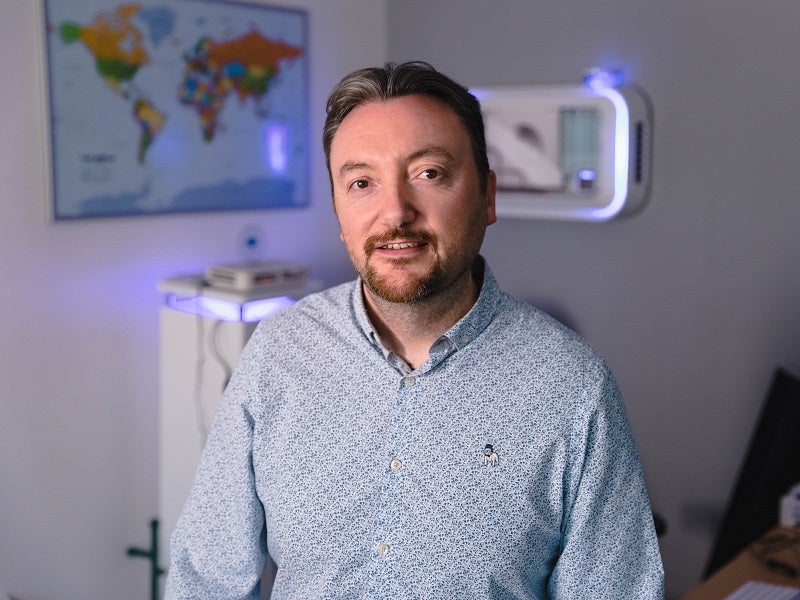
British firm Radic8 has developed an all-in-one solution for air quality management. The sterilisation chamber of the Radic8 air purifier is designed to use a process called photocatalytic oxidation to kill bacteria, viruses and other particulate matter in a single air pass. The company claims it could help manage the spread of Covid-19, and its ubiquity in South Korea may well prove testament to that.
Radic8 CEO and founder Richard Greenwood explains more.
Chloe Kent: How does Radic8 work?
Richard Greenwood: Photocatalytic oxidation, the combination of ultraviolet radiation and titanium dioxide, does two things. One, the ultraviolet radiation will break the RNA or DNA of any pathogens, which will kill a virus or a bacterium. Two, the combination of ultraviolet radiation and titanium dioxide creates something called hydroxyl radicals. These are oxidising radicals. We designed this chamber to maximize oxidisation, and ultraviolet radiation.
CK: Would this work against Covid-19?
How well do you really know your competitors?
Access the most comprehensive Company Profiles on the market, powered by GlobalData. Save hours of research. Gain competitive edge.

Thank you!
Your download email will arrive shortly
Not ready to buy yet? Download a free sample
We are confident about the unique quality of our Company Profiles. However, we want you to make the most beneficial decision for your business, so we offer a free sample that you can download by submitting the below form
By GlobalDataRG: Absolutely, yes. We have partners in South Korea, which is where we manufacture all of our technology as well. They have over 370,000 installations in the country. Over 80% of hospitals use our technology out there and it’s mandatory in all lung examination rooms to use our technology. There are a lot of questions on how South Korea has managed to flatten the coronavirus curve so quickly, and one of the reasons is that they have the best defence against airborne and droplet disease transmission.
CK: What sort of clinical backing do you have to show that Radic8 works?
RG: We’ve tested the Radic8 technology against all of the main virus groups, which includes coronavirus, adenovirus, polio virus, influenza virus. So we’re very comfortable in saying that, providing we get the virus into our unit, have a 99.999% kill rate on a virus, so there’s no virus trace detected once it’s gone through our technology.
What’s really important about this part is that these tests have been conducted on a single air exchange. You can’t run a test in a chamber, and then give a kill rate on technology. That’s what common filters will do. We know that as long as we get the virus into our unit, what comes out is no virus or bacteria or pathogen.
CK: What regulatory approval do you have?
RG: We don’t just install in medical settings; we install in schools, elder care, everywhere, so it’s not technically a medical product – we don’t register with the US Food and Drug Administration (FDA). But it is CE-approved, and in the US it’s UL-approved [certified by Underwriters Laboratories].
CK: Can the device be installed anywhere?
RG: We have five devices for different applications. We also make specialist devices for contamination and disease control, so in that instance we’d have a negative pressure device. We do devices for operating theatres where we also create positive pressure. Then we do bespoke installations in the UK.
We’ve partnered up with the largest ambulance manufacturer in the UK, O&H, and they’ve started installing our Radic8 technology to protect frontline staff.
CK: Where else is the device in active use?
RG: We’re dealing with enquiries from all around the world, we’re pretty much inundated with requests at the moment. We have just flown out some of our devices to the royal clinics in Saudi Arabia. Our technology is being used in the two biggest hospitals in Wuhan.
Another new market in the UK has emerged for us very, very recently, is dentistry. Dentists have to, in emergency cases, still stay open.
CK: Could Radic8 have quite a big role to play in the ongoing pandemic?
RG: I really think so. I think there’s a lot of confusion about droplets. People think they’re large droplets that settle before they dry out but there’s also a great element of small droplets that dry out before they settle, leaving suspended particles. The term airborne gets very confusing for a lot of people. I do believe this is airborne. If we look at SARS or MERS and if they’re anything to go by then I think more and more studies will come out to show that it’s not just aerosolised in medical facilities, I think we’re dealing with an airborne virus.
Two things that greatly enhance infection control are controlling the flow of air, getting anything that’s in the air out of the breathing zone, and what you then do with that air. If you’re going to use a technology, then it has to be a technology that shows a kill rate on viruses. It’s no good putting a filter out there because you could be further endangering people by giving viruses propulsion. It needs to be a technology that both controls the flow of air and kills viruses. Within doing that you’re not only enhancing the protection against airborne and droplet transmission routes, you’re also stopping a lot of surface settlement. You’re reducing exposure of pathogens from direct and indirect contact routes as well.
It’s a shame that this is highlighted by a pandemic like this. What is also being highlighted is that we need to increase our infection control practices, and I suppose we’re just happy that we’ve got something that can help in that fight.







